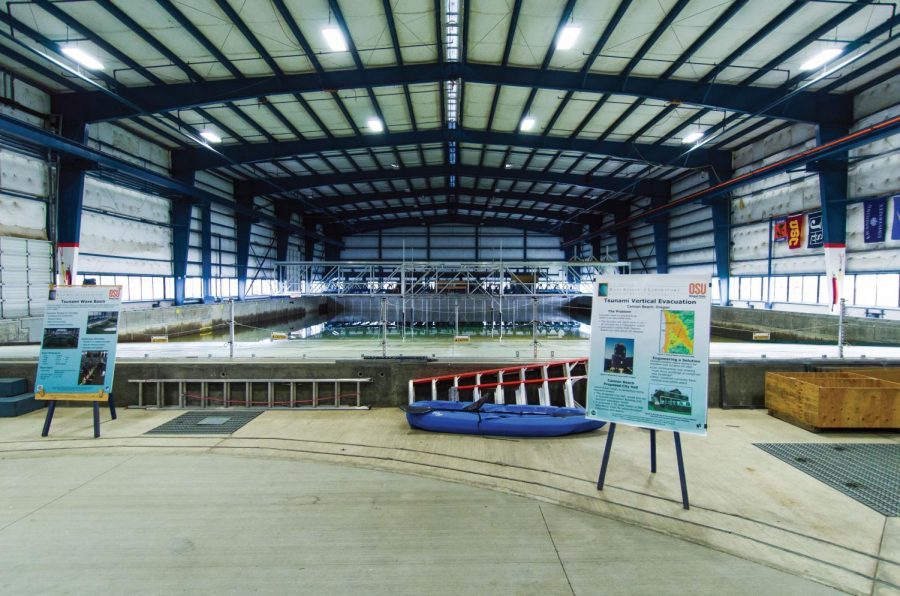O.H. Hinsdale Wave Research Laboratory
January 29, 2016
A five minute drive from the heart of OSU, a peculiar sign says “Warning: Tsunami Hazard” pinned in front of a large grey building. Upon arrival, its quiet atmosphere contrasts the clashing waves painted on the wall and there stands a staff welcoming the afternoon visitors to the Hinsdale Wave Research Laboratory (HWRL).
“O.H. Hinsdale Wave Research Laboratory is the largest tsunami tank in the nation,” said Alicia Lyman-Holt, an HWRL education and outreach coordinator. “The machines can make the longest wavelength that looks like tsunami in the nation.”
According to the NEES@OregonState twitter handle, “O.H. Hinsdale Wave Research Laboratory or also known as HWRL is one of the largest and [latest] laboratories for education, research, and testing in coastal, ocean and related areas.”
There are two main machines, Tsunami Wave Basin and Large Wave Flume. The Tsunami Wave Basin is 160 feet long, 87 feet wide, 4.5 feet deep, and 2.0 feet freeboard; bigger than an Olympic swimming pool. The large size allows the basin to create three-dimensional landslides from the tiny, powder-like sands. Large Wave Flume is 342 feet in length, 12 feet wide, and 15 feet deep, but can generate controlled long waves.
The machine was used to study coastal impacts that are caused by tsunami waves such as inundation areas, which is flooding area resulting by tsunami waves.
Because O.H. Hinsdale Wave Research Laboratory (also known as HWRL) is part of the national NEES system, often times the operation at the Tsunami Research Facility is opened for researchers from NSF’s NEESR grants program. They focus on doing research with the community and engineers who have high technology innovation that can reduce the impact of natural disasters like earthquakes.
NEES experimental facilities had completed or are in progress of about 160 multi-year projects since the first six years of research located at universities across the United States.
There are 14 universities that are participating in this program since 1998, which includes Cornell University, University of California Berkeley as well as Oregon State University.
“We help the researchers prepare their works,” stated Dr. Pedro Lomónaco, the director of O.H. Hinsdale Wave Research Laboratory. “You have to prepare before hand — it is coordinated work. Everyone has to know what is needed,” Lomónaco said.
According to Lomónaco, the preparation itself does not take much time because they just have to send the design to the company. The fastest experiment that he has participated in took only a day. However, it usually takes longer than that.
“Two to four weeks is a good number because we have spent a lot of effort on it; so why not spending a lot of time using the facilities and experience it for many times,” Lomónaco said.
The daily usage rate for the facility is $4,000. Three researchers, Professor Dan Cox from OSU, Jack Puleo, and Tom Hsu from University of Delaware found out that their theorems are very similar to one another. As a result, they congregated to find the solutions to their questions such as but most of the time it takes five to six years to finish one project, Lomónaco said.
HWRL does not only welcome researchers, but also everyone who is interested in it. Elementary to high school teachers can schedule tours for their classes. Moreover, graduates and undergraduates are encouraged to visit or become ambassadors who will learn by doing some training and by being tour guides. This is actually a great benefit that the engineer students in Oregon State University can receive said Lyman-Holt.
“I learned how to fix different kinds of mechanics there. I am doing a mechanical engineering major; it is going to help me to have more knowledge about mechanics,” said Jackie Cheung, an OSU Mechanical Engineering and Mathematics alumni who used to work in HWRL. “Also, professors and I always have conversations about their projects, I learned a lot of new knowledge from (the) discussion.”
According to an article by McClatchy-Tribune Business News (2010), if tsunamis were to happen in the coast of the United States, there is a high possibility of huge destruction because most Americans would not know what they are facing or how should they evacuate from this.
“The visitor experience is more like a presentation,” said Lyman-Holt. “Engineering students will learn by experimenting with building models and waves.”
This way the audience, especially engineering students, will get to see how the machines work in real life rather than just seeing the images from books.
“We all know that we couldn’t just apply from textbook to environment, there should be some uncertainties in the field.” said third year OSU Ecological Engineering student, Danny Luhur.
HWRL does not only have great machines, but they also have a staff, which allows the place to run useful research.
“I do believe on the value of the people,” Lomónaco said. “You can have facilities if you have money but not people. It is very difficult to find people like this.”
























































































































